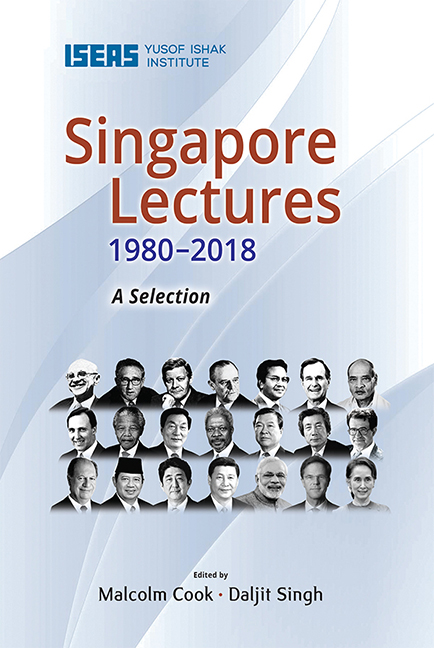Book contents
- Frontmatter
- Contents
- Introduction
- 1 The Invisible Hand in Economics and Politics
- 2 American Foreign Policy: A Global View
- 3 The Soviet Union: Challenges and Responses as Seen from the European Point of View
- 4 Trends in the International Financial System
- 5 Regionalism, Globalism and Spheres of Influence: ASEAN and the Challenge of Change into the 21st Century
- 6 US Policy in the Asia-Pacific Region: Meeting the Challenges of the Post-Cold War Era
- 7 India and the Asia-Pacific: Forging a New Relationship
- 8 Australia, Asia and the New Regionalism
- 9 South and Southern Africa into the Next Century
- 10 China and Asia in the New Century
- 11 Global Values: The United Nations and the Rule of Law in the 21st Century
- 12 Peace on the Korean Peninsula and East Asia
- 13 Japan and ASEAN in East Asia: A Sincere and Open Partnership
- 14 EU and Asia: Sharing Diversity in an Inter-regional Partnership
- 15 Global Challenges in the 21st Century: A View from Chile
- 16 Indonesia: The Challenge of Change
- 17 Japan and ASEAN, Always in Tandem: Towards a More Advantageous Win-Win Relationship through My “Three Arrows”
- 18 Forging a Strong Partnership to Enhance Prosperity of Asia
- 19 India’s Singapore Story
- 20 The Netherlands, Singapore, Our Regions, Our World: Connecting Our Common Future
- 21 Democratic Transition in Myanmar: Challenges and the Way Forward
- The Singapore Lecture Series
- The Editors
8 - Australia, Asia and the New Regionalism
Published online by Cambridge University Press: 09 October 2021
- Frontmatter
- Contents
- Introduction
- 1 The Invisible Hand in Economics and Politics
- 2 American Foreign Policy: A Global View
- 3 The Soviet Union: Challenges and Responses as Seen from the European Point of View
- 4 Trends in the International Financial System
- 5 Regionalism, Globalism and Spheres of Influence: ASEAN and the Challenge of Change into the 21st Century
- 6 US Policy in the Asia-Pacific Region: Meeting the Challenges of the Post-Cold War Era
- 7 India and the Asia-Pacific: Forging a New Relationship
- 8 Australia, Asia and the New Regionalism
- 9 South and Southern Africa into the Next Century
- 10 China and Asia in the New Century
- 11 Global Values: The United Nations and the Rule of Law in the 21st Century
- 12 Peace on the Korean Peninsula and East Asia
- 13 Japan and ASEAN in East Asia: A Sincere and Open Partnership
- 14 EU and Asia: Sharing Diversity in an Inter-regional Partnership
- 15 Global Challenges in the 21st Century: A View from Chile
- 16 Indonesia: The Challenge of Change
- 17 Japan and ASEAN, Always in Tandem: Towards a More Advantageous Win-Win Relationship through My “Three Arrows”
- 18 Forging a Strong Partnership to Enhance Prosperity of Asia
- 19 India’s Singapore Story
- 20 The Netherlands, Singapore, Our Regions, Our World: Connecting Our Common Future
- 21 Democratic Transition in Myanmar: Challenges and the Way Forward
- The Singapore Lecture Series
- The Editors
Summary
On 17 January 1996, Prime Minister of Australia Paul Keating gave the 14th Singapore Lecture after being welcomed by Singapore's Deputy Prime Minister Tony Tan who referred to Mr Keating as “Australia's most Asia-oriented Prime Minister”. Prime Minister Keating was the second of four Australian leaders to give a Singapore Lecture following Prime Minister Bob Hawke in 1987. His lecture is a clear exposition of why Australia has turned its focus to Asia. It also reflects the optimism at the time about regionalism, with Keating regarding APEC as the “new model for regional cooperation” particularly suited for the post-Cold War era.
It is a great honour to have been asked to give this lecture and I thank Professor Chan Heng Chee and the Institute of Southeast Asian Studies for the invitation. Australia has had a long and productive association with the Institute over many years.
I also want to thank the Government of Singapore for its support for the lecture and, especially, Deputy Prime Minister Tony Tan for his courtesy to me in chairing it today.
This is my third visit to Singapore as Prime Minister and it is always a pleasure to come here. There is an energy about Singapore which flows from people who are conscious of the inevitability of change and who are trying to shape that change for the better.
I admire that Singapore, perhaps more than any other place in the world, teaches the vital lesson that we cannot prepare for the future until we know what we want it to be.
This has been the distinctive principle guiding Singapore's modern history: the same principle that some time ago began to guide Australia through the present era. When you face things and begin to do what must be done, you liberate ideas about what can be done. This great era of change has meant that as we approach the centenary of Australia's nationhood a new, stronger and clearer vision of our future has begun to emerge. And it now goes without saying that much of the future we see—we see in the Asia-Pacific.
- Type
- Chapter
- Information
- Singapore Lectures 1980-2018 , pp. 124 - 144Publisher: ISEAS–Yusof Ishak InstitutePrint publication year: 2020

